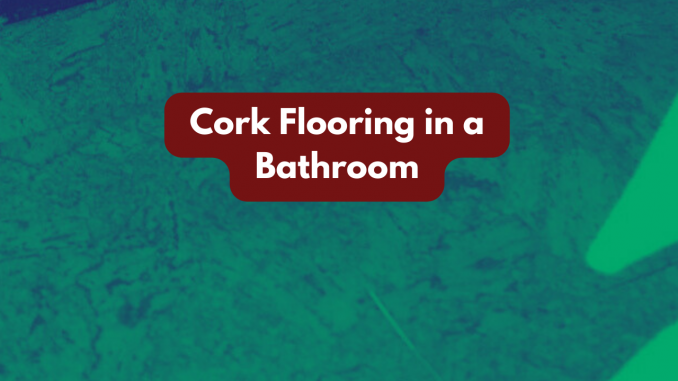
Cork flooring is a type of flooring material made from the bark of cork oak trees. The cork oak is primarily found in the Mediterranean region, with Portugal being a major producer of cork. The harvesting of cork is a sustainable process that involves carefully stripping the outer bark of the trees without causing harm to the tree itself. This process can be repeated every 9 to 12 years, allowing the tree to regenerate its bark.
Cork flooring can be used in a bathroom, but there are some considerations to keep in mind. Cork is a natural material that is resistant to mould and mildew, and it has a certain level of water resistance. However, it is not completely waterproof, and prolonged exposure to standing water can damage the cork.
What to consider when using cork flooring in a bathroom
Sealing
Ensure that the cork flooring is properly sealed to enhance its water resistance. The sealing process creates a protective barrier, reducing the risk of water damage.
Maintenance
Wipe up spills and excess water promptly to prevent any potential water damage. Regular maintenance is important to keep the floor in good condition.
Humidity control
Cork can be sensitive to extreme humidity levels. Make sure the bathroom is well-ventilated and consider using a dehumidifier if necessary.
Water-resistant underlayment
Install a water-resistant underlayment beneath the cork flooring to provide an additional layer of protection against moisture.
Avoid standing water
Cork flooring should not be exposed to standing water for extended periods. This means that bath mats or rugs should be used to soak up excess water around sinks and tubs.
Installation by professionals
Hiring professionals for the installation ensures that the cork flooring is properly laid and sealed, minimizing the risk of water damage.
While cork can be a viable flooring option for bathrooms, it’s essential to follow the manufacturer’s guidelines and take precautions to prevent water-related issues. If you’re concerned about the potential for water exposure, you may also want to explore other flooring options that are explicitly designed to withstand high moisture environments, such as ceramic or porcelain tiles, vinyl, or natural stone.
The Benefits of Cork Flooring
Cork flooring can be a suitable choice for a bathroom, offering specific benefits for this space. Here are the top five advantages of using cork flooring in a bathroom:
Comfort Underfoot – Cork is known for its soft and comfortable feel underfoot. In a bathroom, where people often walk barefoot, the cushioning effect of cork can be particularly appreciated. It provides a warmer and softer surface compared to cold and hard materials like ceramic tiles.
Anti-Slip Properties – Cork flooring has a natural texture that can provide some level of traction, reducing the risk of slipping in wet conditions. This is an important safety consideration in bathrooms where water spillage is common.
Mould and Mildew Resistance – Cork naturally contains a substance called suberin, which makes it resistant to mould, mildew, and pests. In a humid environment like a bathroom, this quality is beneficial for maintaining a clean and healthy space.
Sustainable and Eco-Friendly – Cork is a renewable resource, as it is harvested from the bark of cork oak trees without harming the trees themselves. This sustainable harvesting process makes cork flooring an eco-friendly option. If you are environmentally conscious, choosing cork aligns with a commitment to using renewable materials.
While cork flooring offers these advantages, it’s important to follow manufacturer recommendations for installation, sealing, and maintenance to ensure its performance in a bathroom setting. Additionally, consider personal preferences and the specific conditions of your bathroom to determine if cork is the right fit for your needs.

Leave a Reply